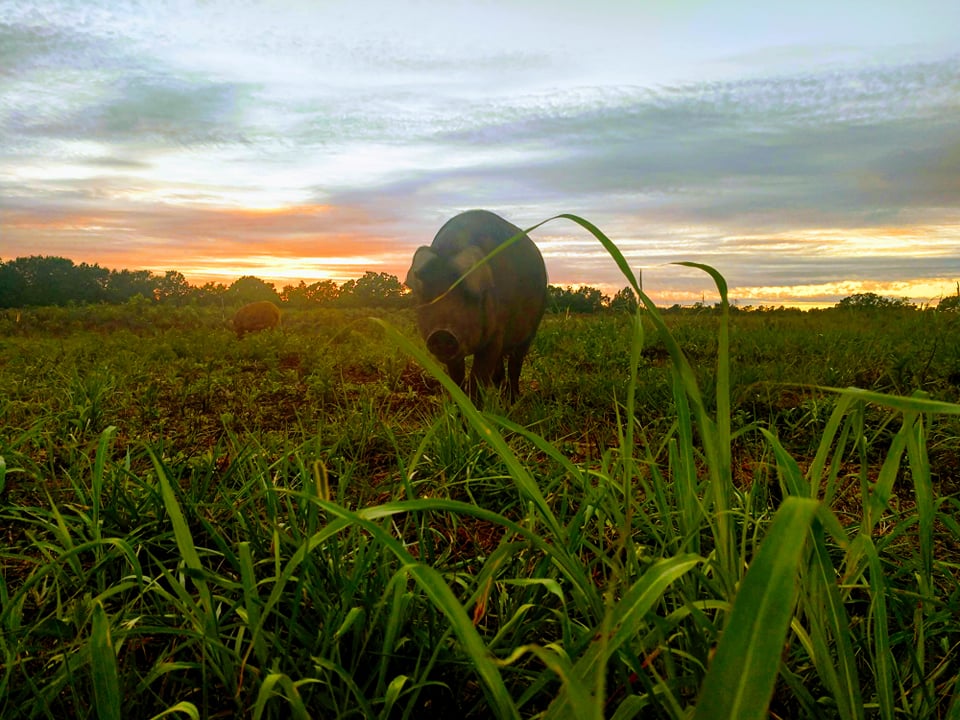So before I start enumerating the differences between pastured pork and confinement pork, I will address the obvious issue with this article. You are currently reading this on The Pastured Pig website which should automatically hint at a certain degree of bias. Also, as the author of this article, I can say I have only managed pigs on pasture. I have never operated a confinement operation nor have I even visited one. The closest I have come to a conventional pig farm was driving by one in Ohio. With that being said, I do want to be as objective as I can when I can and will use references when available.
So, what is the difference between pastured pork and confinement pork (we will refer to it as CAFO pork going forward)? I really prefer to answer a different question that points to my bias. Why is pastured pork BETTER than CAFO pork? There are quite a few reasons why pastured pork is better. To keep it from being just my voice in this discussion, however, I polled people in a Facebook group I belong to called Pastured Pigs for Meat and Profit. I will enumerate the reasons in order of how they ranked them.
#1 Taste – Not only was this the top reason it was also the most emphatically expressed reason. Most grocery store pork is tasteless. That is why you see so many options for seasoning for pork chops available. If you take a slab of meat that has no flavor, then you have to add that flavor at the time of preparing to make it palatable. How many people do you know buy a grocery store pork chop and just throw it on the grill like they would a prime steak? Not too many would be my guess. Now, ask that same question of someone who has experience with pastured pork. That is how we eat them around here. A little bit of salt and olive oil and then they go to the grill. To me, they taste just as good as any cut of steak.
#1.5 Color and Texture – Closely connected to taste is color and texture. A pastured pork chop is red with streaks of white marbling throughout. “The other white meat” was some terrible marketing strategy (that was highly effective) to convince consumers that a grey pork chop is ok. Yuck! Gives me the creeps just thinking about it. CAFO pork is raised to put on muscle and be very lean. Pastured pork encourages a good balance of muscle to fat with good marbling and a nice fat cap (some lard breeds can really build a good fat cap). Texture is important as well. A CAFO pork chop is produced to be consistent. They should all look, feel, and taste the same. This produces a cut of meat that really has no personality. A good cut of pork is firm, not squishy. It is tender and shreds well along the grain. It reacts the way a real cut of meat should.
#2 Animal Welfare – Are pastured pigs just happier pigs? Yes, I think they are. I don’t think anyone could argue keeping a pig indoors and on a man-made floor all the time is better than allowing a pig to do what it was created to do outside on the ground when it comes to contentment of the animal. While we cannot simply ask the pig which it prefers, nature clearly points to what is more appropriate for a pig. When I personally get to see my pigs frolic in the woods or play king of the hill by the wallow (yes, they actually do), then I know they are living their best life. It doesn’t just end with contentment of the animal. Pastured pigs generally have less disease issues than confinement pigs. It doesn’t take a huge scientific study to show that when more ground is allowed per pig then the spread of disease is less. Think of it as 200 people crammed into a busy subway train during cold and flu season. Now, put those same 200 people spread out on a football field. Clearly they are less likely to spread an illness. Less illness means less medical input with antibiotics and vaccines.
#3 Improved Food Quality – There have been several studies done to compare pork produced outside on pasture to confinement pork. These studies have shown the difference in omega 3, fatty acids, and vitamin D. Here are links that discuss those findings:
Fatty Acid Comparisons of Grain and Forage-Fed Pork
Sun exposure in pigs increases the vitamin D nutritional quality of pork
The Nutritional Benefits of Pasture-Raised Food
#4 Environmental Benefits – Some might think that an animal with a shovel on its face can’t be good for the land. While it is true pigs can be destructive (ask anyone dealing with feral hogs), a managed herd of pigs can actually improve the land and soil quality. Compare that to a confinement operation where there are literally tons of manure and urine waste that has to be removed, then it is a no brainer that a pastured pig is better for the planet. When a pig can spread its manure around, the soil gets better. When a pig lightly disturbs the ground (don’t leave him in one spot too long), the soil gets better. When you put a herd of pigs in an undergrowth thicket so dense you can’t walk through it, the soil (and the understory) gets better. A well managed pasture operation should see improved soil quality year after year. Confinement operations can look like sewage treatment plants with their waste impoundments.
There are quite a few more benefits we could enumerate, but I think these 5 (4.5) points are the most important when discussed with fellow pastured pig raisers. If you are considering pasturing hogs or are just starting to sell your pork to customers, I hope this article can provide some talking points that will help convince your customers that your pastured pork is worth the price and is superior to grocery store pork in many ways.




